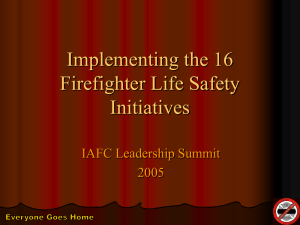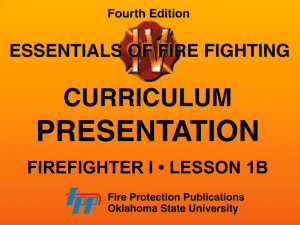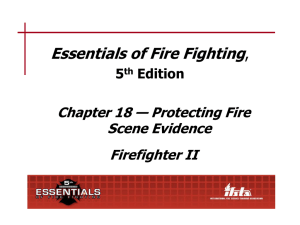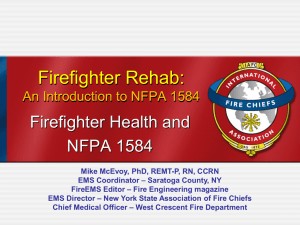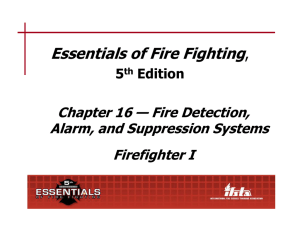Orientation & Safety I - North Carolina Department of Insurance
advertisement
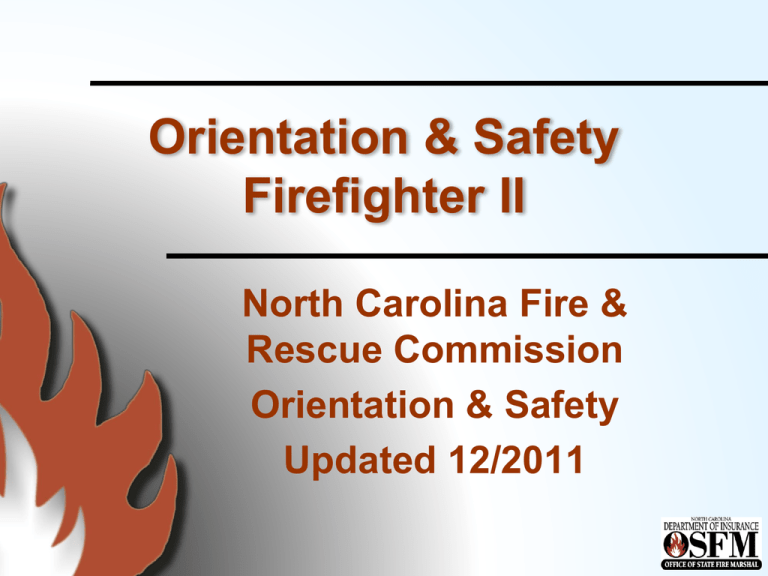
Orientation & Safety Firefighter II North Carolina Fire & Rescue Commission Orientation & Safety Updated 12/2011 Lesson One Firefighter II TERMINAL OBJECTIVE n The Firefighter II candidate shall correctly describe their role within the organization as it relates to their job in emergency and non-emergency situations. Enabling Objectives n n The Firefighter II candidate shall correctly define in writing their role within the fire department . The Firefighter II candidate shall correctly define in writing the responsibilities of assuming and transferring command within the Incident Command System . Firefighter II Role n n The “Role” refers to an expected behavior in all types of pertinent situations with the associated expected results. The Role of the FF II can be broken down into two distinct categories: – Non-combative – Combative Non-Combative Role n Exhibit leadership in the performance of any duty assignment. Exhibit a thorough knowledge of S.O.P.s, Rules and Regulations. Maintenance of equipment. Maintenance of quarters (station). n Maintenance of physical abilities. n n n Non-Combative Role n n n n n Awareness of safety in performance of all duties Take on additional responsibility of higher rank when required. Perform fire inspections within the jurisdiction. Train in accordance with required standards to a high degree of proficiency. Strive to maintain the professional image of the fire service when dealing with citizens. Combative Role n n n They must execute all orders in a timely and precise fashion. Explanation of procedures and methods should be unnecessary. When required, a Firefighter II must be capable of assuming command of an operation until higher-ranking personnel are available. Combative Role n Incident capabilities include: – Respond to alarms in accordance with S.O.P.s, Rules and Regulations. – Perform required fire ground function efficiently and safely. – Assume and transfer command when necessary – Relay any necessary information, and give location of alarms received from dispatch. – Protect life and property to the highest degree possible. – Perform to the highest levels of professionalism. Transfer of Command n In order to assume command of an incident, the Firefighter II must first understand the responsibilities of the command position. – Assesses the incident priorities. – Determines the incident’s strategic goals and tactical objectives. – Develops or approves and implements the incident action plan. – Develops an incident command structure appropriate for the incident. Transfer of Command n Responsibilities of the command position: – Assesses resource needs and orders, deploys, and releases needed resources. – Coordinates overall emergency activities. – Serves as the ultimate safety officer responsible for preventing fire fighter injuries and/or death. – Coordinates activities of outside agencies. – Authorizes information release to the media. Transfer of Command n n Transfer of command is a critical function that must be accomplished efficiently and accurately. The general steps for transferring command include: – Upon arrival of the higher-ranking officer the transfer of command will begin. – Describe what has happened. Transfer of Command n Transfer of command steps: – Whether anyone was / is injured or trapped. – Whether the problem is stabilized or getting worse. – What resources are on scene or enroute. – Whether current resources are adequate for the situation or that more resources need to be called. – The Firefighter II will then listen to the new IC repeat the status report to identify any miscommunication. Review n n n Review the fact that the Firefighter II should be able to explain their role as a member of the fire department organization upon completion of this unit. Review and discuss each of the Firefighter II responsibilities in the assumption of Command. Reiterate each of the points that the Firefighter II must cover in the transfer of command Lesson Two Firefighter II TERMINAL OBJECTIVE n The Firefighter II candidate shall correctly describe the benefits provided to fire department personnel by the utilization of fire department safety standards and list those safety hazards common to operation of fire department tools and electrical equipment. Enabling Objectives n n n The Firefighter II candidate shall correctly define in writing the terms laws and standards. The Firefighter II candidate shall correctly define in writing the goals and objectives as they pertain to safety policies. The Firefighter II candidate shall correctly identify in writing how laws and standards impact a fire department's safety program. Enabling Objectives n n The Firefighter II candidate shall correctly describe in writing the safety procedures to be used for fire service lighting equipment. The Firefighter II candidate, when given various hand or power tools, shall correctly describe in writing the respective safety hazards presented by each. Enabling Objectives n The Firefighter II candidate, when given various power tools, shall correctly describe in writing the safety procedures for ensuring various power tools are in a “ready state”. Laws & Standards n n Laws: rules of conduct that are adopted and enforced by an authority having jurisdiction. Standards: criterion documents that are developed to serve as models or examples of desired performance behaviors. Safety Policy Goals n Goal - a broad, general, nonmeasurable statement of desired achievement. – Prevent human suffering, deaths, injuries, illnesses, and exposures to hazardous atmospheres and contagious diseases. – Prevent damage / loss of equipment – Reduce the incidence and severity of accidents and hazardous exposures. Safety Policy Objective n Objective - a specific, measurable, achievable statement of intended accomplishment. – Objectives should always include a certain timeframe. Laws & Standards – Safety Program n n N.F.P.A. 1500 Standard on Fire Department Occupational Safety and Health Programs can serve as a guide in establishing objectives for making the fire service a safer place. N.F.P.A. 1500 is a minimum standard, none of the objectives are intended to restrict a department or jurisdiction from exceeding the requirements specified by the standard. Laws & Standards – Safety Program n O.S.H.A.s Title 29 of the C.F.R. 1910.120 document involves, as it pertains to a fire departments safety and health program. Ref.: Title 29 of the Code of Federal Regulations (CFR) 1910.120, sub-part L. Lighting Equipment n Fire Department lighting equipment procedures should meet the following: – Run power plants at least once a week for at least 20 minutes, while powering an electrical device. – Check fluid levels weekly. Check gas and oil levels after every use. Drain the power plant of all fluids if it is not to be in service for an extended period. Lighting Equipment n n Wear gloves when changing quartz bulbs. Normal hand oil can cause a bulb to explode when it is energized. Inspect electrical cords at weekly intervals to ensure that the insulation is not damaged. Lighting Equipment n Procedures: – Inspect the spark plug, spark plug wire, and carburetor at weekly intervals. A spare spark plug should also be readily accessible. – Test electrical devices for operating status while the power plant is running. – Change extra gasoline approximately every three weeks to ensure freshness. Lighting Equipment n Cords and connectors should meet the following recommendations: – – – – – 12-gauge 3-wire type (most common). Adequately insulated. Waterproof. Advantages of twist lock connectors Emphasize the importance of utilizing a ground-fault interrupter on any circuit being used at an incident. – Explosion proof. Hand & Power Tool Safety n n n There are numerous fire service hand and power tools. It is essential that safety be paramount whenever using/operating tools. Review your fire department’s recommendations (SOPs / SOGs) as well as the manufacturers recommendations for safe use of hand and power tools. Hand & Power Tool Safety n All tools should be kept in a “ready state”. – All power equipment should be full of fresh fuel. – Damaged or dull blades should be replaced or repaired. – Belts should be checked for correct operating tension and damaged. – All hose fittings should be clean and clear of obstructions. – All equipment should be clean and dry. Hand & Power Tool Safety n n Hand and power tools should be maintained and cleaned according to manufacturer recommendations. Maintenance records should be kept according to departmental SOPs / SOGs. Records should include: – Damaged equipment. – Maintenance record. Review n n n Review the fact that the firefighter should be familiar with the laws and standards that impact firefighter safety, especially NFPA 1500. Review the safety considerations for the operation of power plants and lighting systems. Review the safety hazards associated with the various hand and power tools utilized by the firefighter.
